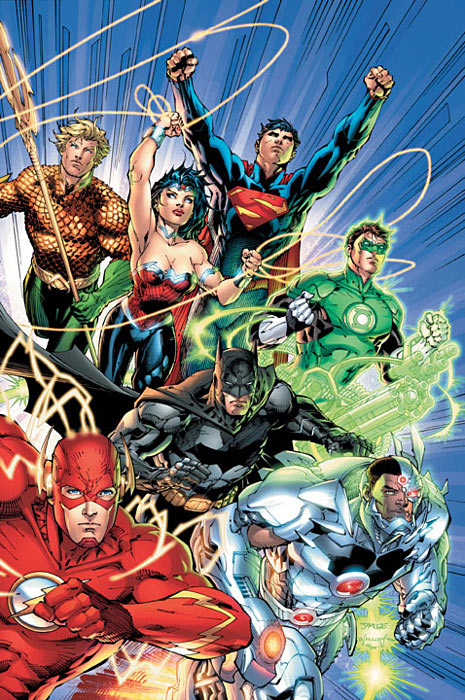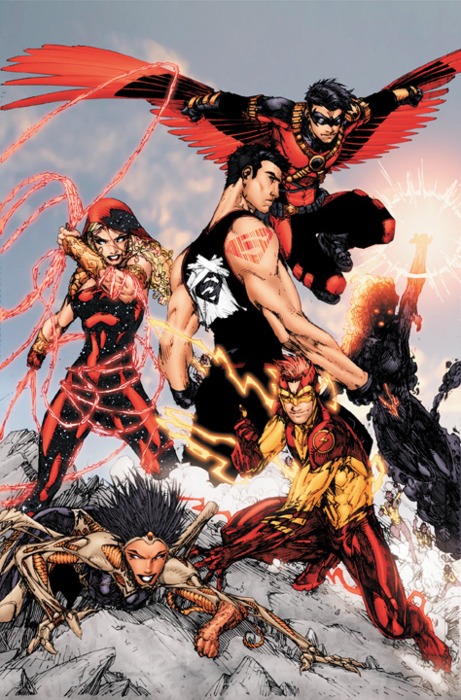Warren Ellis has made it his business to connect with his readers in a very direct way. From his weekly email blasts to appearing at comic cons and generally taking the pulse of the readers, he has long been one of the more informed personalities in comics today. He’s also very approachable and eager to offer up advise on any number of subjects, he even wrote to me about what kind of handheld mobile device I should buy to write scripts remotely. Nice guy. His comics have been big hits on the stands from his early days of Lazarus Churchyard to Transmetropolitan and his big screen successes in having his work adapted into the film ‘Red.’
I say all this because when Warren speaks, people listen and those people are usually the ones looking for advise on what to buy and what to avoid. In this case, Ellis has some intensely interesting things to say about the rapidly approaching reboot of 54 DC Comic Book titles in September.
DC And Digital Comics Strategies
June 29th, 2011 | comics talk
To understand DC Comics’ move to day-and-date with digital editions of their print comics, you have to understand the intent behind their relaunch.One crucial thing hasn’t changed. For as long as I’ve known him, Dan Didio has believed the key to a resurgent DC is reclaiming all the readers the commercial medium lost in the 90s. On the DC Retailer Roadshow, he’s been hammering this home. Recent statements about how commercial comics have gotten boring and that there should be more visual punch in the mode of 90s comics movements like the early Image Comics work and (unspoken, but certainly associated) the Marvel style of that general period… have made their mark, but have also misled a bit. It’s all about accessing that hypothetical lost fan base. The impression the recent statements have left is Dan saying “comics used to sell loads back then, let’s do that again.” And that can’t happen in print.
Comics used to sell loads back then, yes. But a big part of that — and this is the part he isn’t mentioning — is that there were ten thousand comics shops back then. And now there are, optimistically and rounding up, about two thousand. There simply aren’t the number of outlets left to sell the kind of volume comics could shift in the 90s.
The gamble here is this: that hypothetical lost fan base is older, has credit cards and disposable income, and an internet connection that can bring the DC Comics section of a notional comics store right to their desks. That, in fact, digital comics services will do the work of those eight thousand stores that don’t exist anymore.
—————————-
Now, there is a fascinating situation where DC will polybag special issues of JUSTICE LEAGUE #1 with a digital-comic download code, a book that will cost an extra dollar. Comics are done on firm sale. Which means, as far as I can see, that the retailer is being charged extra money on each copy of that edition too. Maybe I’m wrong, and comics retailers aren’t being offered a reacharound while getting an mild yet unwelcome pegging. But it’s an interesting kind of support. DC are offering support to retailers in other ways and are making sympathetic noises, but other quotes from this roadshow — one from Bob Wayne, DC’s head of sales, boiled down to “if you’re not selling enough of our comics you’re not doing your job” — tend to suggest that someone at the company has realised that the comics retailers already have a girlfriend and never liked DC anyway.
Saying that DiDio is looking to get DC Comics back to the 1990’s is terrifying to say the least. That was the decade of the speculator boom, the mass closure of comic shops and more gimmicks than you could shake a foil-covered comic at. The plots were largely nonsensical, the artwork overblown and exaggerated and much of the material produced during that time was later ignored by writers or outright retconned.
However, my gut reaction to the ‘new look’ of the DC Universe was one of derision and disgust as it reeked of the decade that gave us fashion disasters such as chain wallets, acid washed jeans, studded gloves, big hair and small waists. Even Superman got a fade haircut! The books are apparently DESIGNED to be style over substance in an effort to win back lost readers who loved Spawn, Lobo and Extreme Justice. Not that those comics in particular are the worst of the lot, but to use them as a blueprint for a line-wide relaunch smacks of an oncoming disaster for the industry.
Do we really want to see this again?
Look, all I want is a decent Batman and Superman book. Is that possible?



Initial observations full of sadness/irony:
The work of smart, talented (successful!) folks that helped DC mature in the last 2 decades (Alan Moore, Geoff Johns, John Byrne, Grant Morrison etc) are either being ignored or having their ideas dumbed way down to stumble into DC’s new plan.
Newer and modern readers (even on digital platforms) don’t want to collect and purchase junk or have their intelligence insulted, which Didio & Co. seems to be doing across the board….
LikeLike
I’m not part of the regular comics scene anymore… so I can’t fully give a qualified comment on DC’s new reboot.
But I do like one thing I read… I read an article where DC said they were going to stop writing towards designed TPB collections… forcing those 6 part stories.
I remember the olden days of comics where some stories were single issues and others had multiple parts… but all of them had stories and backstories that evolved. I remember, Spider-Man for example since he was my first and favorite super-hero, a time when stuff would happen in a few panels one month… then another month… all while the main story was taking place… then slowly the things that had been happening in the background came to fruition in the foreground as the next main story. The characters and the stories evolved more naturally and fluidly… moving from one situation to the next without a firm/fixed 3 or 6 part entitled story.
You could collect, after-the-fact, some of these as a “collection” for the main story… but the reality was, each issue contained a juicy little tidbit of something yet to come.
I miss that kind of storytelling.
All too often, once the TPB-writing took over… there were 3 or 6 part stories that you could miss those issues and it didn’t affect anything else that came after. You knew that nothing happening before or after would be referenced or integral in any way… and you knew the story was either cut short to fit OR padded to extend to fit… so they could release it as a TPB once the final part came out.
I’m fine with designed mini-series… 6 or 12 issue stories that were entirely planned to need/use only those issues and then the series ends. That is 100% fine. But the ongoing books… I prefer to have them evolve and be at least tenuously connected from one issue to the next… so that the Spider-Man you read about in issue 12 is the same guy in issue 16, but has evolved a bit for his experiences… new characters enter, old ones exit… new adventures build on old ones… and on we go.
Though I used Marvel examples… it applies to DC. It is something both companies seemed to adopt around the same time… and it was disappointing to me.
So… whatever else DC is doing with the reboot… I liked reading this aspect, that they planned on stopping the forced ready-to-be-collected stories in their ongoing books.
LikeLike
I’m not aware of the move aware from ‘writing for the trade’ especially as the tpb format seems to be the preferred method for customers. Single issues are only available from the direct market, being comic shops (dwindling) or bookshops (see comic shops) while trades are available almost anywhere.
In any case, the modern storytelling method of 4 and 6 part stories written toward collections has toned down greatly from when it was initially introduced. Whereas before, you’re right, stories were like TV mini-series and avoided prolonged continuity (a bug bear that was pointed at as the main deterrent for new readers), it is now much smoother. Reading just one trade would give you an idea of what a monthly series is like, but being a regular reader would provide a much richer experience… unless it’s Deadpool or something.
To date, the DC Reboot has shown its spots to be ill thought-out and dangerous to the medium, more likely to cause long standing customers to leave than attract any new ones. That’s not to say there aren’t some pearls in there. I am interested in the Perez Superman for instance, but seriously, read up on this and you’ll weep. It’s like the 90’s all over again (and I never wanted to be the guy who said that).
LikeLike
I don’t love the idea of the reboot… honestly, some of the things they “fix” with reboots could be fixed without that… It’s like dieting. You don’t have to start on Monday or the first day of the month. You can (and should) start today… it’s a crutch to your own pessimism to tie one thing to another… so they tie “fixes” with reboots, though I guess that gives them an “out” to un-reboot if something doesn’t work.
Anyway… FYI, the article I read was on ICV2 entitled “No More ‘Writing to Trade’ Six-Issue Story Arcs Blamed for Industry Malaise” and here’s a link to it: http://www.icv2.com/articles/markets/20432.html
LikeLike